Home → Fish & Wildlife → Wildlife → Species Information → Mammals → White-tailed Deer → Maine Deer Spy → Rut Watch
Rut Watch
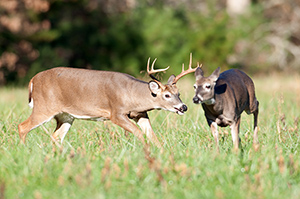
Background
In years past, MDIFW staff would examine female white-tailed deer that were hit by cars to determine whether they were carrying any fetuses and how developed those fetuses were. By looking at fetal development, it was possible to estimate the date of conception. This gave MDIFW some insight into peak whitetail breeding periods, or the peak of the rut, and a general understanding of rut timing. This data collection was messy work, time consuming, and could be unsafe if conducted roadside. For these reasons, sample sizes were limited with just a few tens of deer examined each year, and these efforts were discontinued in 2018.
To gather information about whitetail rut timing and breeding behaviors from hunters and wildlife watchers, we’ve added the Rut Watch survey to our Maine Deer Spy project. You may report any observed breeding season behaviors, such as a buck mounting a doe, buck rubs, scrapes, sparring, and chasing. For information on each of these behaviors, please see the Frequently Asked Questions section below.
How to Participate
Participating is easy! When you observe any white-tailed deer breeding season behaviors between October 1 and December 31, please click the link below and submit your observations.
- Location
- Date and time
- Breeding behavior observed: a buck mounting a doe, buck rubs, scrapes, sparring, and/or chasing.
Frequently Asked Questions
What can you tell me about observed breeding?
A buck breeding a doe, or copulation, is the most obvious indication that breeding is occurring on the landscape. This is a rare behavior to witness. A buck will often “tend” a doe, following her closely until she is prepared to breed, and the buck may test the doe’s readiness by nuzzling or pawing at her rump. Once the doe is receptive to breeding, the buck will stand behind the doe and mount, and copulation typically consists of a single hard thrust before the doe moves out from under the buck.
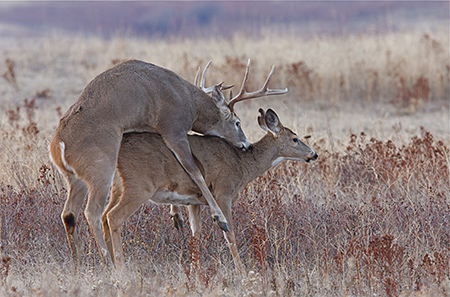
What can you tell me about chasing behavior?
Before a doe is receptive to a buck’s attempts at copulation, bucks will follow in her wake waiting for her to become receptive. Bucks will typically trail behind, often seen with nose to the ground, but may occasionally get close to the doe.
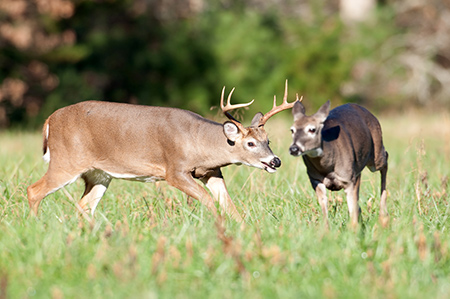
What can you tell me about sparring behavior?
Sparring begins after bucks shed their velvet and is intended to help sort out a dominance hierarchy. Early in the season, sparring matches are often short and low intensity, but matches between similar sized bucks later in the season can be much more intense. Sparring behavior is mostly completed by the time breeding is taking place.
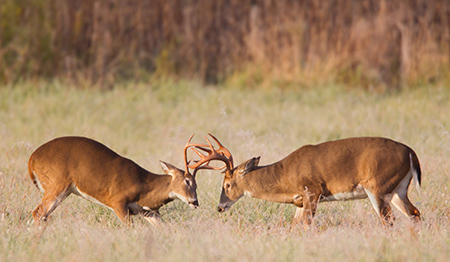
What can you tell me about buck rubs?
A buck rub is the quintessential sign that fall is upon us in the deer woods. Rubs are made when deer rub their antlers and foreheads on trees, removing bark and depositing their scent in the process. These rubs communicate a buck’s presence in an area. While any size or age of buck can rub on small trees, a rub on a large tree of 4 or more inches in diameter means a big buck is in the area.
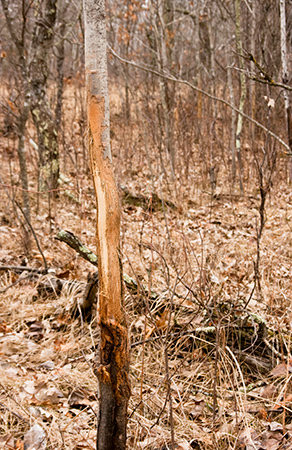
What can you tell me about buck scrapes?
Scrapes consist of two components: a licking branch and a patch of cleared earth. A buck will break a low branch (around head height) and then paw the earth beneath the branch, depositing scent on the branch as well as the bare earth patch in the process. They will sometimes urinate over their tarsal glands onto the scraped-up earth as well. Scrapes likely serve many functions, but among them is the scrape’s function as a signpost signaling a buck’s presence in the area and attracting the attention of other deer in the area. Both bucks and does will visit active scrapes, and bucks will sometimes freshen a preferred scrape if leaves or other debris have covered them over.
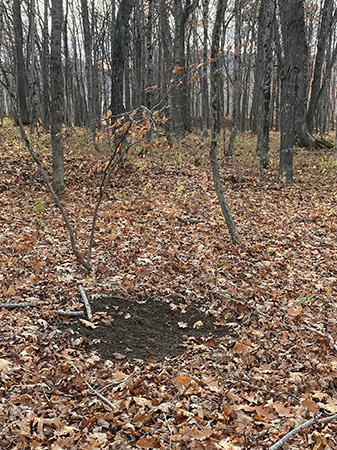
How do I know if the rub or scrape that I see is fresh?
Scrapes: A fresh scrape should have a branch or branches over-hanging around head height, often with some sign that the branches have been chewed on or broken. The scrape will be mostly exposed earth, free of leaves and debris. You might even detect a musky odor near to the scrape if a buck has recently urinated on it. Note that other wildlife activity such as turkey scratching may sometimes resemble a scrape; a buck scrape will typically be just a few feet in diameter and consist of an exposed patch of dirt, whereas turkey scratching is usually over a broader area and consists of over-turned leaves and some small patches of exposed dirt.
Rubs: A fresh rub will typically expose brighter layers of inner bark, which will contrast with the dull outer bark of the tree. There will often be strands of shredded bark or deer hair or velvet still hanging from the rub, and the rub will have a rough appearance. Older rubs- particularly from years prior- will be all dull in appearance and relatively smoothed over.
Progress & Future
Data from this project are compiled at the end of each observation season and will be summarized each year in the MDIFW Research and Management Report.